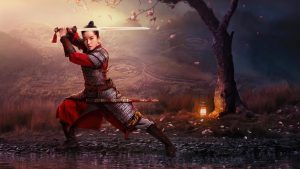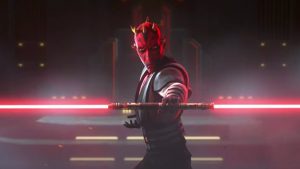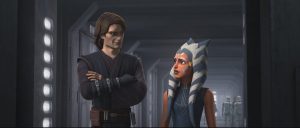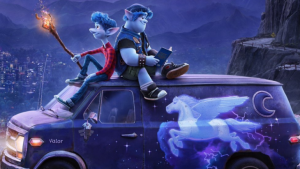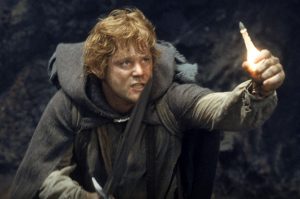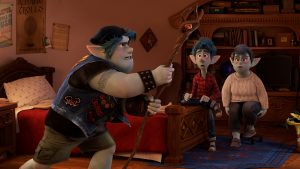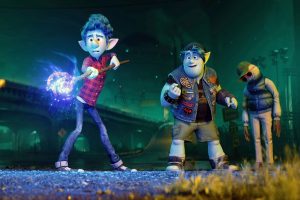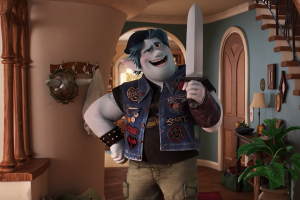CLONE WARS SPOILERS AHEAD!
Aided by a magical combination of fabulous voice-acting, stunning animation and mind-blowing writing, the tenth episode of The Clone Wars‘ seventh and final season has not only managed to exceed my wildest expectations (which were already high!), but has also quickly emerged as one of my favorite episodes of the entire series: all seven seasons, every choice made along the way, has led us to this – and the payoff is just as rewarding as we all hoped it would be (and mind you, the real payoff is still ahead: this is just a warm-up exercise for what’s to come!).
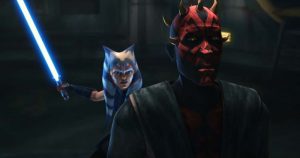
Not a moment of screentime is wasted. This episode doesn’t even open with Tom Kane’s iconic voice-over recap, instead placing us directly into the action and drama, right where we left off last week – with Ahsoka Tano (voiced by Ashley Eckstein), alone and outnumbered, standing against the massive, hulking might of Darth Maul (voiced by Sam Witwer) and his small but deadly army of loyal Mandalorian terrorists. But the fighting takes a moment to get started, because Maul, characteristically, has something he needs to say – and Witwer brings his all to the role this week (not that he ever doesn’t, but he’s particularly good now), truly elevating the material and dialogue he’s working with – which is already so well written that it’s sparked some jokes on the internet, where Maul is currently trending on social media platforms, about where the former Sith apprentice had time to take a crash course in political sciences. But along with an expanded vocabulary, Maul arrives on the scene newly equipped with a fascinating humanity and philosophical, introspective attitude: something that might have been hard to imagine back when Maul was first introduced in Star Wars: The Phantom Menace as the mute, cool-looking apprentice of Darth Sidious – in fact, it might still have been hard to imagine even when Maul was resurrected in an earlier season of The Clone Wars as a monstrous creature tormented by a lust for vengeance. But over time, as showrunners and screenwriters have slowly recognized his potential, he has transformed into one of the series’ most compelling characters: a villain, but one slowly moving into the extreme middle of the divide between the Sith and the Jedi. He may still fight with his classic, doubled-bladed red lightsaber, but he is just as much a neutral third party as Ahsoka Tano herself. Is he turning to the light side of the Force? No. Is he becoming more fair and just in his old age? No. But as he himself quips during the episode: “Justice is merely the construct of the current power base”. Maul is now working on his own, outside the influences of either Chancellor Palpatine’s Republic or Darth Sidious’ Separatist Union, looking to establish a place for himself in the coming chaos. But in the episode’s biggest, most shocking twist he reveals that he can’t do it alone – so he reaches out to Ahsoka for her help.
And Ahsoka wavers. Maul touches on all her weaknesses, pointing out that she left the Jedi Order willingly, because she could not stand for their hypocrisy and corrupt politics. He reminds her that the balance of power in the galaxy is about to shift, and that the Jedi will collapse in a matter of days, maybe even hours, or minutes. He informs her that Darth Sidious has been playing both sides of the Clone Wars, toying with the agendas of both the Jedi and the Sith. Ahsoka, whose entire arc has led her straight into the same neutral zone as Maul, can’t help but see the truth and reason in his words. She doesn’t hesitate long: she agrees to join him. But then Maul ruins his own masterfully crafted plan when he tells Ahsoka that her Jedi master, Anakin Skywalker, is destined to become Darth Sidious’ greatest tool and weapon in the fight to topple the balance of the Force. And Ahsoka, unable to reconcile with the idea that Anakin could ever betray her, makes her move, rejecting Maul’s proposal and initiating…a light-saber duel.
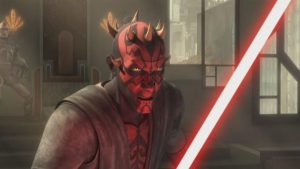
What a duel! With original Darth Maul actor Ray Park returning to perform the motion-capture for his character, and Lauren Mary Kim doing the same for Ahsoka Tano, the fight feels fully realized and unique. The action sweeps through the great throne room of Mandalore (which turns out to be an amazing set-piece, something that became clear to me when the hall’s stained-glass windows all simultaneously shattered inwards, ensnaring the duelists in a breeze of flying, multi-colored shards), and then gets carried out into the fiery hellscape of the city itself, where Maul’s loyalists are fighting the Mandalorians led by Bo-Katan (Katee Sackhoff). Everything you want from a light-saber fight, you get in this episode – there’s acrobatics and a precarious balancing-act at one point, the opponents both have dazzling elegance, and there’s a lot of Force use involved.
But in the end, it’s Ahsoka, surprisingly, who gets the upper hand – catching Maul with her Force powers as he falls, pleading to die, and holding him there until her clone troopers can take him hostage. With Maul’s forces already surrendering on the ground, it looks like the Siege of Mandalore might already be over: but the season isn’t, which means something big is still coming.
It’s not too hard to take a guess as to what that might be. On the margins of the episode’s story, we hear little snippets of news about how the Clone Wars is going: Count Dooku is dead by Anakin Skywalker’s hand, and Obi-Wan Kenobi (James Arnold Taylor) is on his way to kill General Grievous on Utapau, meaning it shouldn’t take very long to get to the great purge, and the systematic extermination of the Jedi across the galaxy. In this episode, we already saw ARC trooper Jesse (Dee Bradley Baker) become a prisoner of Darth Maul and surrender his mind to the powerful Sith – it’s possible that something occurred offscreen during their encounter that will cause Jesse’s programming to malfunction, leading him to attack Ahsoka before Order 66 has even begun. That could give Ahsoka some warning so that she can try and save some of the other clones under her command – or she might be forced to kill them all to save herself, which would be heartbreaking and utterly brutal to watch. All I know is that somehow, someway, Darth Maul is going to escape from his bonds – and a chaotic melee between his captors would pose the perfect opportunity for him to do just that.
So what do you think? How are you enjoying this final season of The Clone Wars, and what do you think will happen next? Share your own thoughts, theories and opinions in the comments below!
Episode Rating: 9.5/10

